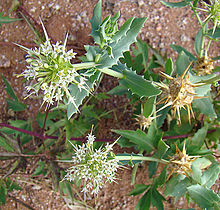Calyceraceae
| Calyceraceae | |
|---|---|

| |
| Calycera calcitrapa | |
| Scientific classification | |
| Kingdom: | Plantae |
| Clade: | Tracheophytes |
| Clade: | Angiosperms |
| Clade: | Eudicots |
| Clade: | Asterids |
| Order: | Asterales |
| Family: | Calyceraceae R.Br. ex Rich.[1] |
| Genera[2] | |
| |
Calyceraceae is a plant family in the order Asterales. The natural distribution of the about sixty species belonging to this family is restricted to the southern half of South America. The species of the family resemble both the family Asteraceae and the Dipsacaceae.[3][4]
Description
Calyceraceae are perennial or annual herbs. There may be a few or many branched stems that may be without hair or with soft silky hairs. The leaves may be in a rosette at the base of the stems or set
Both Calyceraceae and Asteraceae have their flowers set in heads with a common floral base. The bracts surrounding the flowerhead in the Calyceraceae are leaf-like while the involucral bracts in the Asteraceae differ clearly from the leaves. The anthers are free in the Calyceraceae and form a tube in the Asteraceae. The filaments in the Calyceraceae are, at least in their lower third, fused to the corolla, whereas in the Asteraceae the filaments are free or rarely connected (e.g. in Barnadesia).[3]
Both Calyceraceae and Dipsacaceae have persistent calyces, but these become lignified or spiny in Calyceraceae, but are cup-shaped or consist of a circle of hairs in the Dipsacaceae. Stamens are alternating with the corolla lobes and anthers open at their top in the Calyceraceae whereas stamens are centered on the petals and anthers open toward the middle of the flower in the Dipsacaceae.[3]
Genera
Eight genera are accepted:[2]
- Acicarpha Juss. – 7 species, Peru and northeastern Brazil to northern Argentina
- Anachoretes S.Denham & Pozner – 1 species, northwestern Argentina
- Asynthema S.Denham & Pozner – 1 species, Argentina and central Chile
- Boopis Juss. – 2 species, Argentina, northern Chile, and Uruguay
- Calycera Cav. – 6 species, Peru and southern Brazil to southern Argentina
- Gamocarpha DC. – 13 species, Argentina and Chile
- Leucocera Turcz. – 7 species, Argentina and Chile
- Moschopsis Phil. – 10 species, Argentina and Chile
Distribution
The majority of species in this family occur in Argentina, seven of which are endemics, with the highest species density south of the tropics. Calycera (eleven species) and Acicarpha (five species) both are widespread along the Andes from northern Argentina through to the Altiplano of Peru. Most of the thirteen species of Boopsis occur in the south of Argentina and Chile but some species are found in the tropics. Moschopsis grows in the Salta Province in Argentina. Acicarpha tribuloides occurs as an introduced weed along roads in Florida.[3][5]
References
- hdl:10654/18083.
- ^ a b Calyceraceae R.Br. ex Rich. Plants of the World Online. Retrieved 18 November 2023.
- ^ a b c d e Hind, D.J.N. (2009). Milliken, W.; Klitgård, B.; Baracat, A. (eds.). Neotropical Calyceraceae. Neotropikey - Interactive key and information resources for flowering plants of the Neotropics. Archived from the original on 2021-08-28.
- . Retrieved 2016-02-28.
- JSTOR 23312753.
